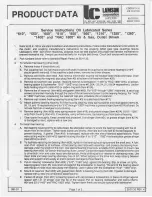
•
Do not store the machine or fuel container inside where there is an open flame, spark or pilot light
such as a water heater, furnace, clothes dryer etc.
•
Observe proper disposal laws and regulations for gas, oil, etc. to protect the environment
•
Always refer to the operator’s manual for proper instructions on off-season storage.
•
At the end of the average useful life
have the machine inspected annually to ensure that all
mechanical and safety systems are working properly and not worn excessively. Failure to do so can
result in accidents, injuries and death.
•
Tampering with the governor setting can lead to a runaway engine and cause it to operate at unsafe
speeds. To avoid serious injury or death, do not modify the engine in any way.
WARNING
Unexpected auger movement may cause personal injury. Before servicing, repairing or inspecting the snow
thrower, disengage the auger control. Stop the engine and remove the ignition key to prevent unintended start
up.
Cleaning the engine
WARNING
Accumulation of debris around the muffler could cause a fire. Inspect and clean before every use.
NOTE
Do not spray the engine with water to clean it because the water could contaminate the fuel. Using a garden
hose or pressure washing equipment can also force water into the muffler opening. Water that passes through
the muffler can enter the cylinder and cause damage.
If the engine has been running, allow it to cool for at least half an hour before cleaning. Periodically remove dirt
build-up from engine.
Lubrication
Lubricate the pivot points on the control handle and the extension spring at the end of the control cable with a
light oil once every season and before the snow thrower is put into storage at the end of the season
Motor
WARNING
Unexpected start up may cause personal injury. Before servicing, repairing or inspecting the snow thrower,
disengage the auger control. Stop the engine and remove the ignition Key.
Periodic inspection and adjustment of the engine is necessary to maintain high level performance. Regular
maintenance will also ensure a longer service life. The required service intervals and the type of maintenance
to be performed are described in the table below. Follow the hourly or calendar intervals, whichever occur first.
More frequent service is required when operating in adverse conditions.






































